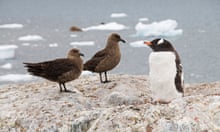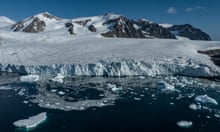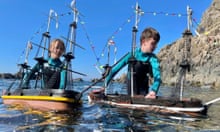The Antarctic, one of the world’s last great wildernesses and home to animals such as whales, penguins and leopard seals, is being threatened by the plight of an animal just a few centimetres long, according to scientists.
Researchers and environmental campaigners warn that a combination of climate change and industrial-scale fishing is threatening the krill population in Antarctic waters, with a potentially disastrous impact on larger predators.
A study co-authored by George Watters, lead scientist for the US government delegation to the Antarctic decision-making body Convention for the Conservation of Antarctic Marine Living Resources (CCAMLR), warns that the penguin population could drop by almost a third by the end of the century due to changes in krill biomass.
“You could potentially have some significant decline in the number of predators – particularly for penguins – caused by climate change,” said Watters.

The report, published in the journal Plos One, warned that climate change could reduce krill size by up to 40% in some areas of Antarctica’s Scotia Sea causing a drastic reduction in predator numbers.
Researchers also said that current permitted rates of krill fishing “increased the risk for depletion of some predator populations” although it had “less impact than ocean warming”.
“I am not advocating removing fishing entirely from Antarctic waters,” said Watters. “People that make management decisions just need to be aware that you can still have an impact on predator populations by managing the krill fisheries more effectively.”
Krill are a key part of the delicate Antarctic food chain. They feed on marine algae and are a key source of food for whales, penguins and seals. They are also important in removing the greenhouse gas carbon dioxide from the atmosphere by eating carbon-rich food near the surface and excreting it when they sink to lower, colder water.
Prof Alex Rogers, who is a specialist in sustainable oceans at the Oxford Martin School, Oxford University, said: “Climate change is having an impact [on the krill population] at the same time as a resurgence in krill fishing, with increasing numbers of fishing vessels and changes in technology that are causing increasing krill catches.”
Krill populations have declined by 80% since the 1970s. Global warming has been blamed for part of that decrease because the ice that is home to the algae and plankton they feed on is retreating.
Campaigners say recent developments in fishing technology are exacerbating the problem, allowing ‘suction’ harvesting by large trawlers which are now able to gather up vast quantities of krill.
These fishing fleets are feeding a growing global demand for krill-based health products which are claimed to help with a range of ailments from heart disease to high blood pressure; strokes to depression.
A recent analysis of the global krill industry predicted it was on course to grow 12% a year over the next three years.
In response, a global campaign has been launched to turn a huge tract of the seas around the Antarctic into the world’s biggest sanctuary, protecting wildlife and banning all fishing.
The 1.8m sq km reserve would cover a vast area of the Weddell Sea and a small part of the Antarctic Peninsula, and is one of three proposed new sanctuaries under consideration by CCAMLR.
The idea was originally put forward by Germany and is now supported by the EU. A decision is likely to be made at a CCAMLR conference in October.

Last month, Greenpeace launched a campaign in support of the sanctuary.
Will McCallum of the group’s Protect the Antarctic Campaign said the report underlined that the area already faced “multiple threats”, adding it did not need “additional strain” from krill fishing.
“Whether it’s fishing near penguin foraging grounds around the Antarctic Peninsula and the East Antarctic, or their expansion plans for the vast and pristine Weddell Sea, the krill industry needs to know that the Antarctic is not theirs to exploit, but all of ours to protect.”
Andrea Kavanagh, director of the Pew Charitable Trust’s Protecting Antarctica’s Southern Ocean campaign which funded the latest study, said the findings showed the importance of creating a network of sanctuaries.
“This study shows that, with more urgency than we previously thought, we need to get these marine protected areas in place and they need to be “no take” – they have to be fully protected areas.”
But Cilia Holmes, sustainability director at Aker BioMarines, one of the leading krill fishing companies based in Norway, said there was “no sound scientific evidence that the krill fishery poses a threat to the Antarctic ecosystem”.
Krill fishing, she said, was already strictly regulated by the Antarctic nations with the total krill catch making up just 0.4% the estimated krill biomass in the area around the peninsula.
Holmes added that “protecting the Antarctic ecosystem” was critical to Aker BioMarines long-term operation.
“We believe in a future where there still is room for well-managed fisheries that take care of the surrounding ecosystem.”
Dr Susie Grant, from British Antarctic Survey, and part of the UK delegation to CCAMLR, said BAS scientists and the UK government were fully in favour of the new protected area in the Weddell Sea but said there remained a case for carefully managed, sustainable fishing in some Antarctic waters.
“While some parts of the Southern Ocean require a higher level of protection, it makes sense to allow sustainable and responsible fishing in areas where we know the risks are low and it can be managed effectively.”
She added: “If a system of scientifically sound reserves can be established to protect Antarctic marine ecosystems, this will send a strong signal as to how we might manage and protect the oceans globally.”
- Matthew Taylor’s trip to Antarctica has been partly funded by Greenpeace










